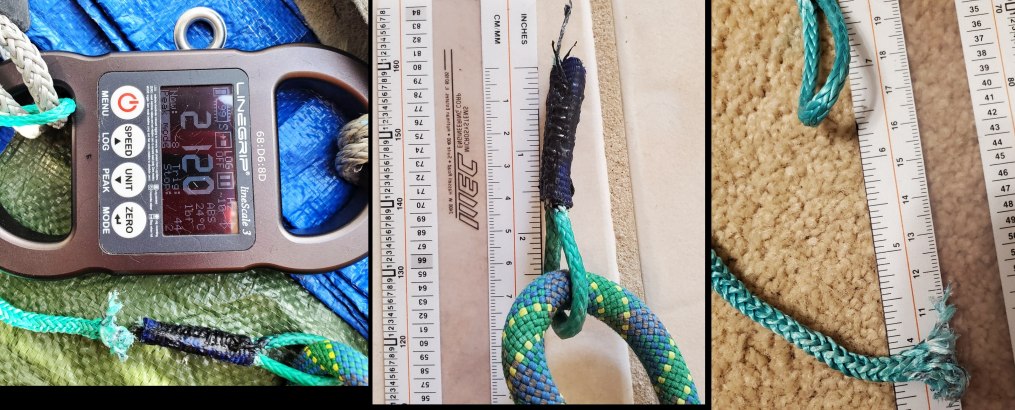Sewn Amsteel Eye breaks at 85% full strength
When I first started working with Amsteel, I sewed, rather than
spliced, eyes in the end. I never intended to use the eye on 1/8"
Amsteel for more than a pull cord; I tested the eyes to 1400 lbs,
without breaking them. Since a pull cord would probably never see more
than body weight, I felt that was OK. My pull setup involved a crappy
come-along, a 1100 lb-limit scale, and a mechanical-advantage system
with a high-efficiency pulley; it was a pain to set this thing up. The
other limit I had: my dominant hand is partly paralyzed, and splicing
was, back then, very frustrating (until I got a D-Splicer).
So as time has gone by, and my break setup is a lot easier to use, I
wondered how strong sewn eyes really were. There are times when you
really do want to sew, rather than splice -- like when you can't afford
11" devoted to bury of a tapered tail.
The setup was the same as for many of my tests-- not a slow pull, but
the force was provided by my jeep. I let the jeep roll downhill till
the line was taut, then hit the gas slightly, for a break less than 2
sec after. One end of the Amsteel had a bury eye splice (loose sewing
just to keep it from pulling out, should be full-strength), and the
other end had the sewn loop. There was a short (1.5m) section of 10.2
mm dynamic rope inline to act as a force buffer.

The break was immediately at the end of the stitching, at 2120
lbs. Given that the stitching covered just 1.5", this is a decent
result.
For the stitching, I made a bight in the rope, and the two strands (out
of the bight) were first sewn together in much the same way as here.
After first sewing the two strands together with 300 lb bs UHMWPE
braided fishing line, I slid a 1.5" section of 1/2" (1000 lb bs)
tubular webbing over both strands, then stitched through the webbing
and two Amsteel strands with a spiral pattern of more 300 lb thread,
this time going through each strand perpendicular to the first set of
stitches. At the end I saturated the nylon sheath with seam grip
urethane.
This loop was sewn 6 years ago, and I've since learned ways to increase
the strength -- don't pull the stitches too tight, especially near the
ends of the sewing.
